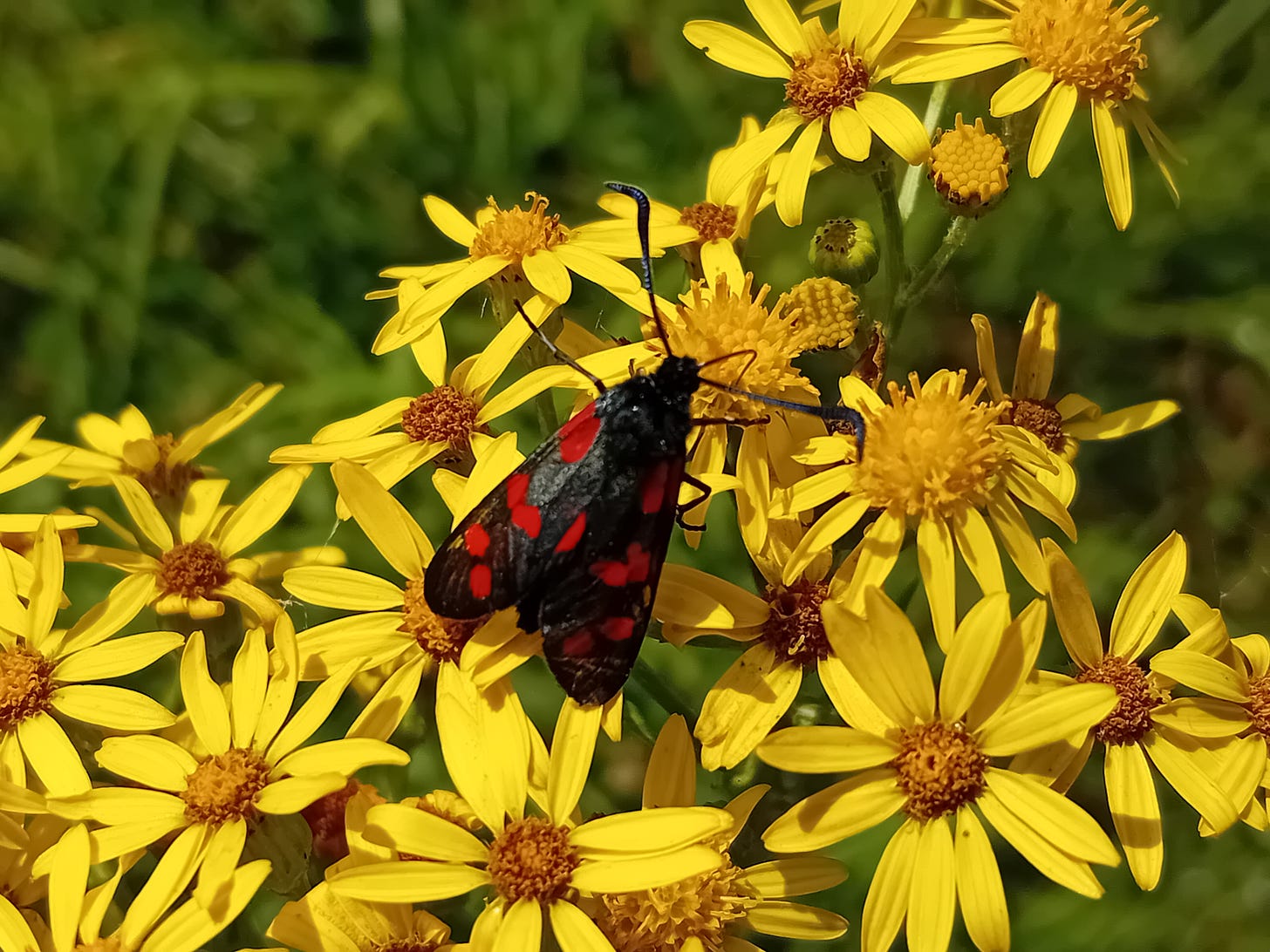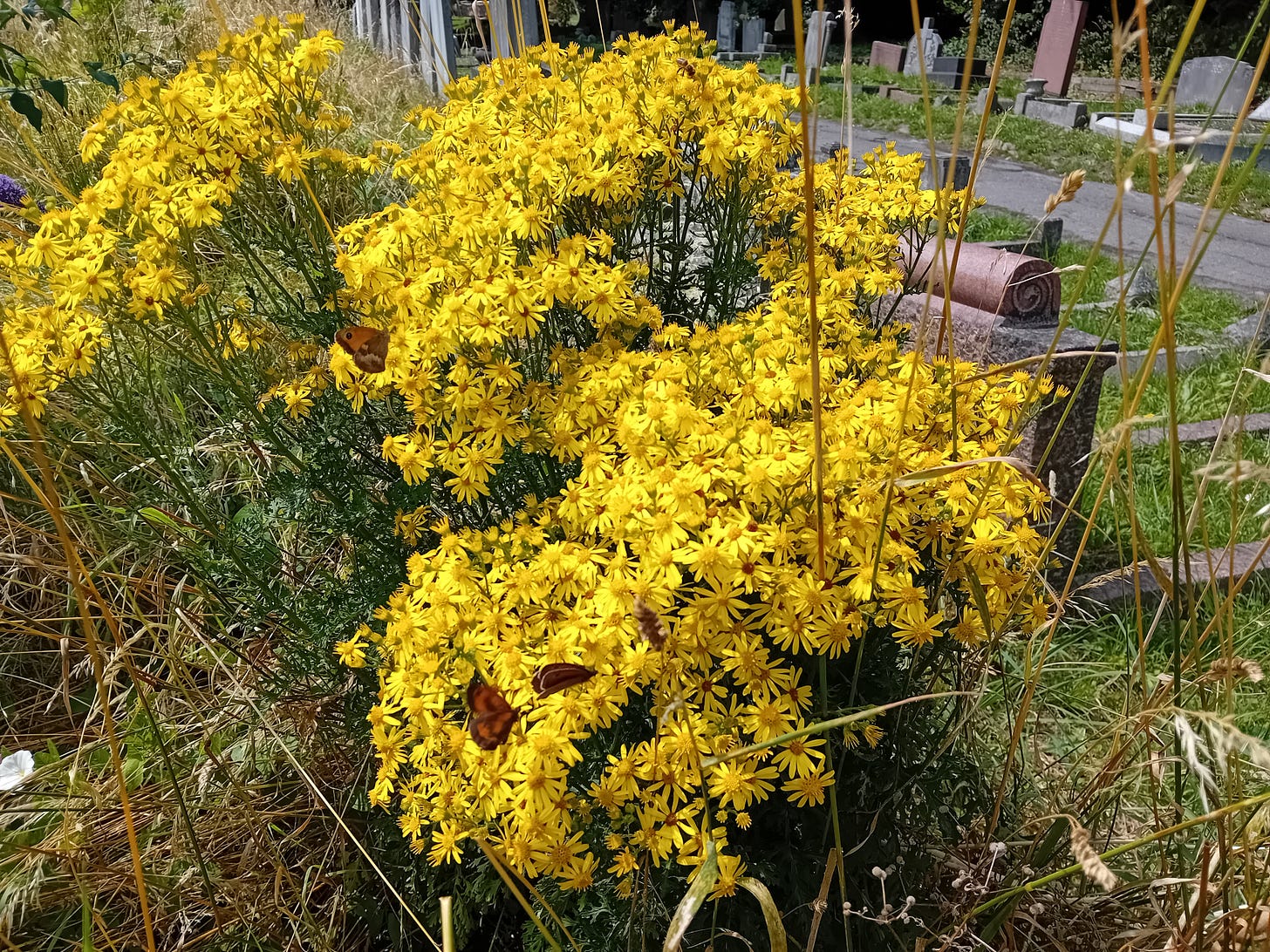Gold beauties or toxic weeds?
On controlling ragwort and why we should leave more of it to grow

In the 1830s, the nature poet, John Clare, wrote a poem praising the “beauties manifold” of a “humble flower with tattered leaves”. He was describing ragwort, a plant which is native to the UK and whose clusters of yellow daisy-like flowerheads still brighten many road verges and scraps of land in the summer months, but which is now more likely to be the subject of heated debate rather than poetry.
Common ragwort (Senecio jacobaea) is a biennial plant, producing a leafy rosette in the first year of its life cycle and tall flowering stalks in the second year. An opportunist which spreads rapidly across patches of bare or disturbed ground, it tends to do particularly well in overgrazed or neglected pastures and is less susceptible to drought than other species. The abundance of ragwort in some places this summer may well be a response to the extensive drought we experienced in the UK in 2022.
When Isabella Tree and Charlie Burrell began the Knepp rewilding project, leaving ragwort to grow was by far the most contentious issue among their neighbours. The controversy arises from the fact that ragwort can be toxic for horses and other grazing livestock because it contains pyrrolizidine alkaloids which cause liver damage. If there is plenty of other food nearby, most livestock will usually avoid eating ragwort while it’s growing as they don’t like the bitter taste, but they can’t detect this in its dried form so are unable to avoid ragwort if it’s included in hay or silage.
Such is the concern about common ragwort that it is one of five wildflowers named as an “injurious weed” in the Weeds Act 1959, along with spear thistle, field thistle, curled dock and broad-leaved dock. Landowners are required to prevent the spread of these plants to neighbouring land if it is used for grazing or producing hay or silage but if there is no such land nearby, the plants can be left to grow in peace. The legislation applies equally to all five plants but there is a particular anxiety about ragwort as it is the only one which is harmful to animals. The Department of Environment, Food and Rural Affairs (Defra) has even produced a code of practice on how to prevent its spread.

Mowing and grazing are an important part of the management of many of the wildflower meadows we help care for as conservation volunteers so one of our regular activities over the summer is pulling ragwort. As it’s wonderful to spend a few hours surrounded by the sights, sounds and scents of a wildflower meadow in high summer, this used to be one of my favourite tasks, but I’ve developed mixed feelings about it since learning more about the plant we’re removing. As common ragwort is nectar rich and often continues flowering after other plants have died off, it supports numerous bees, butterflies, moths and other insects. A study cited in a Defra-commissioned review in 2013 reported 178 species of pollinating insects (including 47 bee species and 35 hoverfly species) as having been recorded visiting ragwort flowers. These insects will be an important food source for birds and mammals too.
One insect species which is heavily dependent on ragwort for its survival is the cinnabar moth which lays its eggs on the plant. When the caterpillars emerge and start eating the ragwort, they store some of its toxins thus making themselves unpalatable to birds and other predators. A study in 2003 found that the number of cinnabar moths had dropped dramatically since 1968 due to the eradication of ragwort. In the two decades since then, numerous studies have identified significant declines in the numbers of insects of all types. While multiple other factors have contributed to this ranging from pesticide usage to habitat loss, reducing an important food source can’t have helped and the charity, Buglife, has argued strongly against the unnecessary removal of ragwort.

Despite its benefits for wildlife, there are some who would like to see ragwort banished completely because of the potential risk to livestock. In her book about Knepp, Wilding, Tree devotes a whole chapter to ‘Living with the Yellow Peril’ in which she suggests that much of this anti-ragwort sentiment is prompted by a misperception about the plants ability to spread rapidly because it produces so many seeds. Tree explains that although each plant produces up to 30,000 seeds, the majority - 60% - fall around the base of the plant, most of the rest land within a few metres and only one or two will travel over 35 metres. Ragwort seeds can survive for at least ten years in the soil, and it is generally these seeds which germinate rather than windblown seeds which tend to be lighter and are likely to be infertile. To allay their neighbours’ fears, Knepp have adopted an injurious weeds policy which includes removing all ragwort from a 50m strip around the boundary of their site but also makes clear that the total elimination of ragwort is neither a legal requirement nor desirable given its ecological importance.
My most recent experience of pulling ragwort was in an enclosure at Sanderstead to Whyteleafe Countryside Area which is to be grazed by sheep later in the year. It was a dull, cloudy day with a hint of rain in the air which meant there were fewer insects about, but the meadows still looked and smelt amazing, and at lunchtime we were treated to the sight of a pair of kestrels hovering low over the adjacent field as they hunted for their meal. While the evidence suggests that sheep and goats are more tolerant of the toxins than other livestock, they can still be harmed and unfortunately, sheep don’t have the same instinct for avoiding ragwort as horses, even seeking out its flower heads to eat. Grazing will ensure that this enclosure can provide a home for a rich variety of plants, insects, mammals and birds in future years. So, even though, I feel slightly conflicted about removing a plant that supports so much wildlife, I understand why we need to do it here. But, as is so often the case in nature conservation, there is a balance to be struck if we want the species that live alongside us to thrive and we need to see more landowners adopting a relaxed approach to leaving ragwort to grow on road verges, uncultivated land and other places where it is not doing any harm.
To finish….
…a few things I’d like to share:
Ragwort facts: This website draws on published scientific research to provide useful evidence aimed at correcting some of the false information that has been circulated about ragwort. There is a particularly interesting section on the common myths about ragwort which starts by explaining that the British Horse Society’s claim that ragwort is “extremely toxic” to horses is based on a survey which overestimated the toxicity by around 10,000 times.
#WeAreNature campaign: I’ve long been uncomfortable with talk of ‘connecting with nature’ as it implies that this is something from which we are otherwise removed when in fact we are as much a part of nature as a bumble bee, a cinnabar moth, or a ragwort plant. So I was interested to learn recently about a campaign to change UK dictionary definitions of the word ‘nature’ to include humans. You can find out more and support the campaign by signing their petition here.
Dogs helping spread wildflower seeds: After my recent post about the negative impacts of dogs on wildlife, it is good to see that someone has come up with an idea for using dogs to benefit urban nature reserves. The Railway Land Wildlife Trust in Lewes in East Sussex is running a pilot scheme which involves strapping specially designed satchels filled with wildflower seeds to dogs. The intention is that as the dogs roam about seeds fall out of the satchel and are spread to areas of the nature reserve which they might not reach otherwise. The effects will only become apparent next Spring so it’s too early to judge whether the idea has been a success.




Fab post Ruth. It's a great plant for urban gardens.
Excellent post, Ruth. I've never really understood why ragwort is so actively removed from so many places where animals aren't grazed! I can on the other hand understand farmers removing it from fields, even if in fact they're being over cautious.
I've noticed more ragwort around this year, I hadn't realised that this was probably due to the recent droughts, as you point out. Three don't seem to be as many cinnabar moth caterpillars around this year though, not yet anyway.